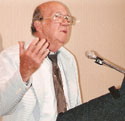Charlotte, Sixty Years Later
In an essay for The New York Times Book Review, Michael Sims describes the barn where Charlotte hung her web
April 23, 2012 Michael Sims is a curious—but not a nosy—biographer, as Chapter 16‘s Serenity Gerbman pointed out in her review of Sims’s bestselling 2011 book, The Story of Charlotte’s Web: “White was famously reclusive and—strange as it may seem for a biographer—Sims understands and respects that need for privacy. Allowing White’s words and experiences to speak for themselves, he offers readers a deeper understanding not only of the life and mind that created Charlotte’s Web, but of the creative process that led to the book and of the sheer work it entailed. The Story of Charlotte’s Web is quite literally that: a biography of the book itself. How did it come to be? What forces and experiences throughout White’s life shaped him and converged to bring his timeless classic into being?”
Now Sims, a Crossville native and former Nashville resident, has taken another brief foray into the life of E.B. White. Writing in The New York Times Book Review, he celebrates the sixtieth anniversary of the publication of White’s classic with an essay about the barn where Charlotte lived:
The barn was very large. It was very old. For more than a century before E. B. White and his wife, Katharine, purchased the farm in 1933, the barn had stood on a rise above Allen Cove, Me., near the village of North Brooklin. For White, the barn was the center of their 40 acres, even more so than the big white house that was attached to it by an aromatic woodshed. The building united White’s two great writerly loves—barnyard animals and Maine. During his long career he wrote about everything from the predictability of radio preachers to the emotional fallout from nuclear dread, but he meditated upon farm animals and Maine life with particular affection.
Read the rest of this lovely essay here.
Click here for links to Chapter 16‘s coverage of Michael Sims’s books and essays—and to reviews and essays that Michael Sims has written for Chapter 16. For more updates on Tennessee authors, please visit Chapter 16’s News & Notes page, here.

